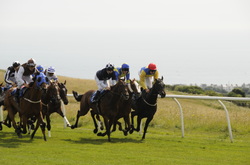 Horses racing on the downs at Brighton racecourse. Source: Pippin Photography.
Horses racing on the downs at Brighton racecourse. Source: Pippin Photography. But the real gem came when I found a book on the internet titled: The Brighton Races, written and published by Jim Beavis in 2003 that looked like it might provide everything I needed to write my scenes at the Brighton race tracks. Coincidentally, my critique partner happens to live in Brighton and was able to track the book down because it was not available to purchase online.
Brighton was always a tourist destination due to its proximity to the sea, but because of the excellent turf and the Prince of Wales’ fascination with the place, it became a popular racing venue in 1783. This was the year the race track made the racing calendar and royalty brought their horses there to race. The Prince of Wales became a regular visitor, bringing with him his court. The curious onlookers inevitably followed.
The race track fell in and out of favor from the 1820s on, but in its heyday, Brighton race track was the place to be for gentlemen and ladies. They would wear their finery and promenade along the grass lawn below the stands prior to the races. The consecutive races in Goodwood, Lewes, and Brighton were called the “Sussex Fortnight” and was a regular part of the social season for aristocrats and thoroughbred owners.
This historical account is full of colloquial gems I would never have been able to discover on my own. These included local news accounts of the scoundrels of the day, “welshers” as they were called, who took bets from unwitting “punters” and ran off with their money while the victims watched the race. According to Beavis, these scammers would offer better odds on the horses than other bookmakers to lure in their victims in. “Nobbling” horses that were favored to win by drugging them or their jockeys was another ploy used by criminals to win bets placed on horses with higher odds.
There were so many race tracks during the Victorian era that they became a breeding ground for these types of illicit activities. Particularly for Brighton, the railroad heralded a new era for the race track. A new heyday for Brighton began when Londoners and other tourists could make it to Brighton by train, the racecourse drew crowds of up to 30,000. The local newspaper kept track of the petty crimes by reporting them in the section of the newspaper called “Race Hill Cases”: stories of pickpockets, rowdies, and robbery of local establishments.
The tracks became a scapegoat for the crimes that had nothing to do with horse racing but because they attracted people in organized crime. Gangs became commonplace by World War One. When, in 1934, a large trunk was found at the Brighton station with the body parts of a woman, Brighton was dubbed “the queen of slaughtering places” instead of its nickname “the queen of watering places”. Beavis speculates that Graham Greene drew his inspiration for his famous 1947 novel Brighton Rock from the gang warfare that had its beginnings at the racecourse.
Since World War Two the race course at Brighton has had some ups and downs. By the 1990s it was in disrepair and needed a major facelift, which it received in 1998. It now hosts the popular Ladies Day with prizes for the best dressed ladies. Things have indeed come full circle.
 RSS Feed
RSS Feed
